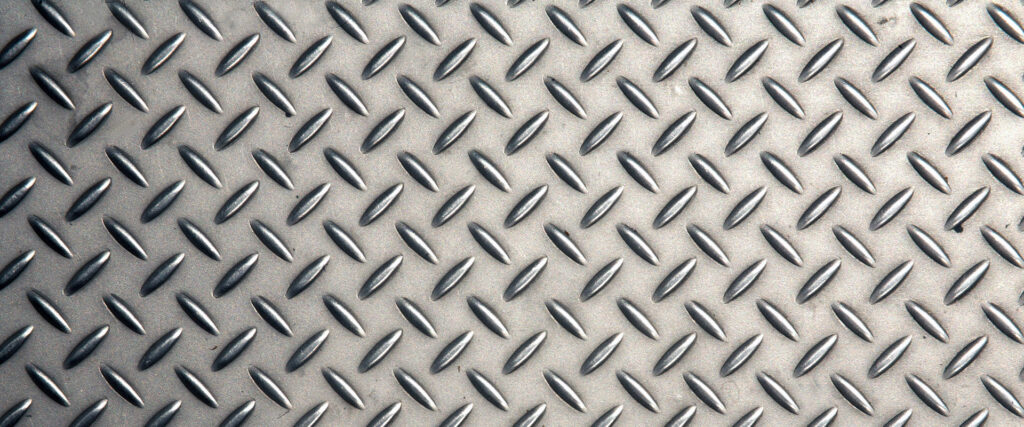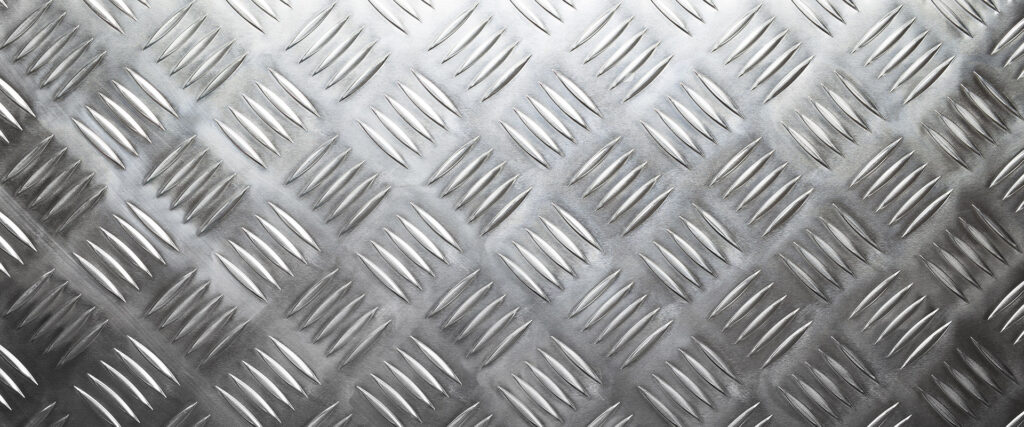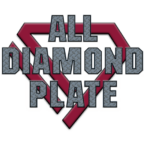Carbon & Galvanized Steel Diamond plate
Carbon Steel Diamond Plate

Carbon steel diamond plate, sometimes referred to as floor plate or checker plate, is a type of steel that has a raised, diamond-shaped pattern on its surface. This textured design serves both functional and aesthetic purposes. Carbon steel is an alloy made primarily of iron and carbon, where the carbon content typically ranges between 0.05% and 2.1% by weight, depending on the grade. The diamond pattern is embossed into the metal to improve its grip and slip-resistance properties, making it particularly useful in environments where safety and durability are essential.
Characteristics and Composition:
Carbon steel, as the base material for diamond plates, is known for its strength and durability. The higher the carbon content in the steel, the stronger and harder it becomes, but it can also become less ductile and more brittle. Diamond plates are typically made from low to medium carbon steel, which provides a balance between strength and malleability, allowing the material to be both durable and easy to fabricate.
Carbon steel diamond plates are widely used in industrial applications due to their mechanical properties. They are often hot-rolled, a process where the steel is heated to a high temperature and passed through rollers to achieve the desired thickness. This hot-rolling process gives the steel its final shape and imparts some degree of toughness. After rolling, the diamond pattern is pressed into the surface, giving the plate its signature look.
Applications:
The primary purpose of carbon steel diamond plates is to provide traction in environments where slipping is a concern. The raised diamond pattern offers excellent grip, making these plates ideal for walkways, stair treads, ramps, and industrial flooring in environments like factories, warehouses, and loading docks. They are also commonly found in vehicles, especially for flooring in trucks, trailers, and utility vehicles, where their non-slip properties are essential.
Another advantage of carbon steel diamond plates is their ability to withstand heavy loads. Their robust nature makes them a suitable choice for areas that experience significant wear and tear or where equipment and vehicles frequently pass over the surface.
Carbon steel diamond plates are also used in decorative applications. The raised pattern can enhance the appearance of a space or product, adding an industrial, rugged aesthetic to both functional and ornamental applications. In addition, they are relatively easy to cut, weld, and form, allowing for flexibility in various designs and uses.
Advantages and Disadvantages:
One of the main advantages of carbon steel diamond plates is their cost-effectiveness. Carbon steel is widely available and relatively inexpensive compared to other materials like stainless steel or aluminum. This makes carbon steel diamond plates a popular choice in industries where cost is a significant factor.
Another key advantage is their strength. Carbon steel diamond plates are resistant to heavy impacts and wear, making them suitable for demanding environments. The raised pattern also contributes to their slip-resistance, improving safety in places where workers might encounter slippery surfaces.
However, carbon steel does have some drawbacks. One of the most significant disadvantages is its susceptibility to rust and corrosion. In environments exposed to moisture, carbon steel diamond plates can corrode over time if not properly treated or maintained. To combat this, coatings such as paint or anti-corrosion treatments are often applied to extend the lifespan of the plates.
Galvanized Steel Diamond Plate

Galvanized steel diamond plate is similar to carbon steel diamond plate in terms of composition and applications, but it has an additional layer of protection. Galvanization is a process in which a protective coating of zinc is applied to the steel to prevent rust and corrosion. This zinc layer acts as a sacrificial barrier, meaning it will corrode before the steel underneath does, thus prolonging the life of the diamond plate in harsh or outdoor environments.
Characteristics and Composition:
The process of galvanization typically involves dipping the steel plate into molten zinc, which forms a strong bond with the surface. This zinc coating not only improves the material’s resistance to rust but also adds a layer of protection against chemical exposure and other environmental factors. The diamond pattern is embossed either before or after the galvanization process, depending on the manufacturing technique.
Galvanized steel diamond plates have all the same mechanical properties as carbon steel plates, including strength and durability, but with enhanced resistance to corrosion. This makes them ideal for applications in outdoor environments or areas exposed to moisture, chemicals, or extreme weather conditions.
Applications:
Galvanized steel diamond plates are widely used in construction, transportation, and manufacturing industries. They are commonly found in outdoor staircases, catwalks, loading ramps, and other environments where the material is exposed to the elements. They are also used in the construction of platforms, safety walkways, and other infrastructure that requires both strength and corrosion resistance.
In addition to industrial uses, galvanized steel diamond plates are also employed in marine environments, such as ship decks and dock ramps, where exposure to saltwater and humidity would quickly corrode untreated steel.
Advantages and Disadvantages:
The primary advantage of galvanized steel diamond plate is its enhanced resistance to rust and corrosion. This makes it suitable for long-term use in environments where untreated carbon steel would deteriorate quickly. The zinc coating also makes the material easier to maintain, as it requires less frequent painting or surface treatment compared to plain carbon steel.
However, galvanization adds to the cost of the material, making galvanized steel diamond plates more expensive than non-galvanized carbon steel plates. Additionally, while the zinc coating provides significant protection, it can wear off over time, especially in high-traffic areas.
